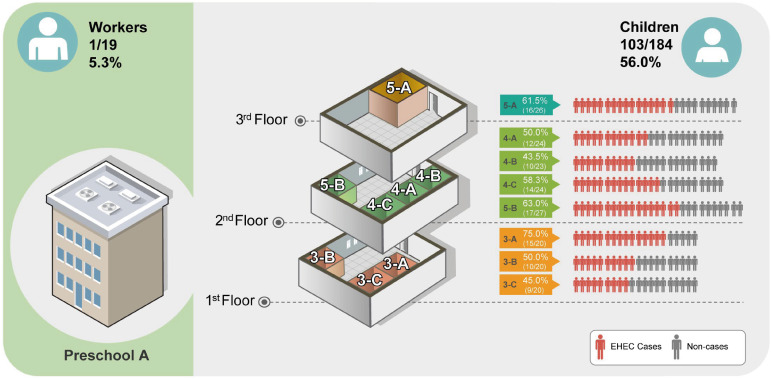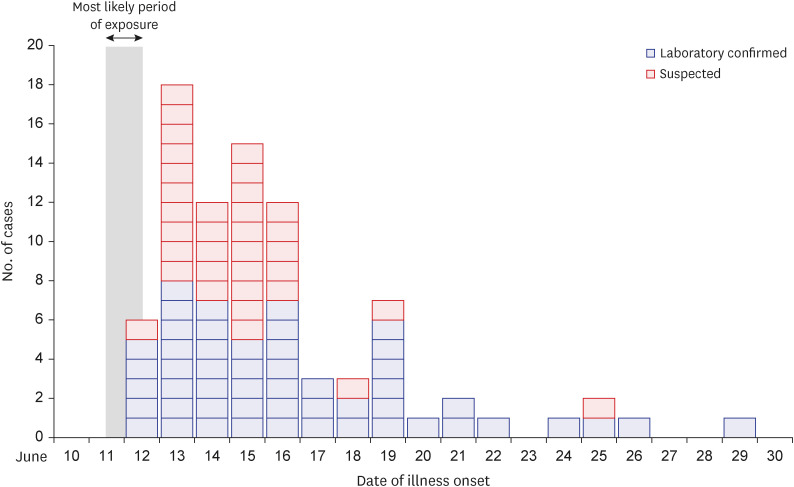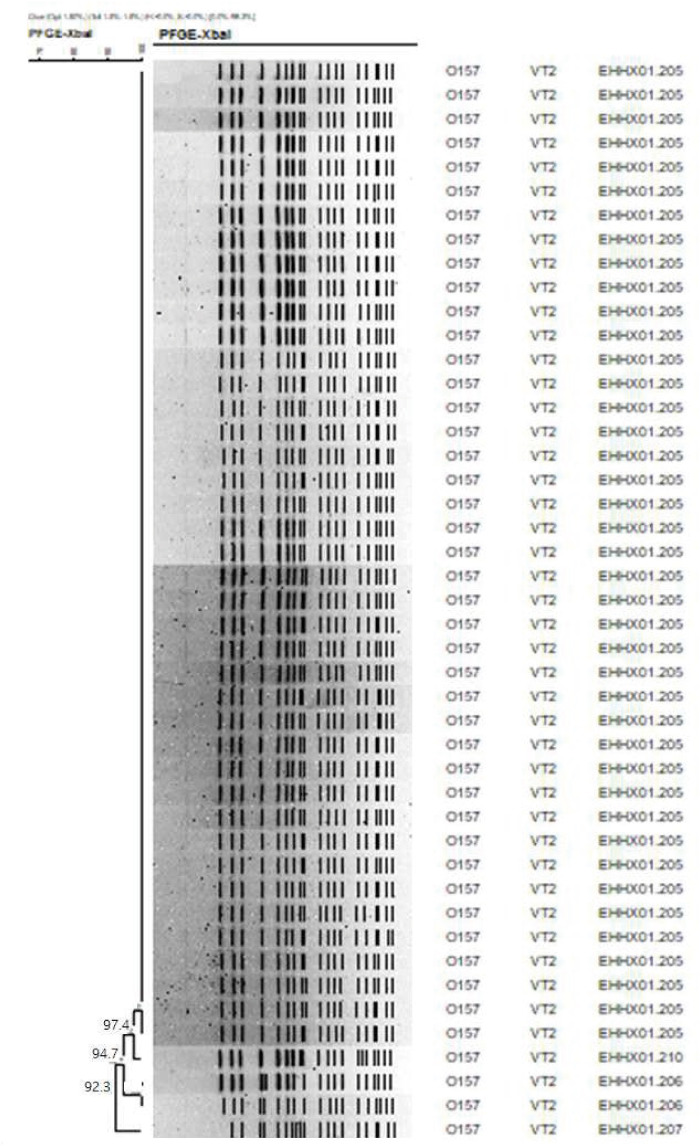J Korean Med Sci.
2023 Apr;38(15):e117. 10.3346/jkms.2023.38.e117.
The Epidemiological and Clinical Characteristics of the Largest Outbreak of Enterohemorrhagic Escherichia coli in Korea
- Affiliations
-
- 1Division of Infectious diseases, Department of Internal Medicine, Yongin Severance Hospital, Yonsei University College of Medicine, Yongin, Korea
- 2Division of Disease Control Policy, Gyeonggi Provincial Government, Suwon, Korea
- 3Korea Disease Control and Prevention Agency, Cheongju, Korea
- 4Gyeonggi Infectious Disease Control Center, Suwon, Korea
- 5Division of Biostatistics, Department of Biomedical Systems Informatics, Yonsei University College of Medicine, Seoul, Korea
- KMID: 2541555
- DOI: http://doi.org/10.3346/jkms.2023.38.e117
Abstract
- Background
The largest outbreak of enterohemorrhagic Escherichia coli (EHEC) O157:H7 occurred at a preschool in South Korea from June 12 to 29, 2020. This study aimed to analyze the epidemiological and clinical characteristics of EHEC infection in this outbreak.
Methods
Epidemiological investigation was performed on all 184 children and 19 workers at the preschool using a standard questionnaire to assess symptoms, food intake, attendance, and special activity history. Pulsed-field gel electrophoresis analysis of confirmed cases was performed to determine genetic relevance.
Results
During this outbreak, 103 children were affected, whereas only one infection was identified in adults. Of the 103 pediatric patients, 85 had symptoms (82.5%), including diarrhea, abdominal pain, bloody stool, fever, and vomiting. Thirty-two patients (31.1%) were hospitalized, 15 (14.6%) were diagnosed with hemolytic uremic syndrome, and 4 (3.9%) received dialysis treatment. Pulsed-field gel electrophoresis analysis identified 4 genotypes with high genetic relevance (92.3%). Epidemiological investigation revealed that this outbreak might have occurred from ingesting foods stored in a refrigerator with a constant temperature above 10°C, which was conducive to bacterial growth. Despite several measures after outbreak recognition, new infections continued to appear. Therefore, the preschool was forced to close on June 19 to prevent further person-to-person transmission.
Conclusion
Our findings from the response to the largest outbreak will help prepare countermeasures against future EHEC outbreak.
Keyword
Figure
Reference
-
1. Nataro JP, Kaper JB. Diarrheagenic Escherichia coli . Clin Microbiol Rev. 1998; 11(1):142–201. PMID: 9457432.2. Majowicz SE, Scallan E, Jones-Bitton A, Sargeant JM, Stapleton J, Angulo FJ, et al. Global incidence of human Shiga toxin-producing Escherichia coli infections and deaths: a systematic review and knowledge synthesis. Foodborne Pathog Dis. 2014; 11(6):447–455. PMID: 24750096.3. Pires SM, Majowicz S, Gill A, Devleesschauwer B. Global and regional source attribution of Shiga toxin-producing Escherichia coli infections using analysis of outbreak surveillance data. Epidemiol Infect. 2019; 147:e236. PMID: 31364563.4. Centers for Disease Control and Prevention(CDC). National Shiga toxin-producing Escherichia coli (STEC) Surveillance Annual Report, 2017. Atlanta, GA, USA: US Department of Health and Human Services, CDC;2021.5. European Centre for Disease Prevention and Control (ECDC). Control. Shiga-toxin/verocytotoxin-producing Escherichia coli (STEC/VTEC) infection. Stockholm, Sweden: ECDC;2020.6. National Institute of Infectious Diseases. Enterohemorrhagic Escherichia coli (EHEC) infection as of March 2020 in Japan. IASR. 2020; 41(5):65–66.7. World Health Organization. Shiga Toxin-producing Escherichia Coli (STEC) and Food: Attribution, Characterization and Monitoring. Geneva, Switzerland: World Health Organization;2019.8. Rosales A, Hofer J, Zimmerhackl LB, Jungraithmayr TC, Riedl M, Giner T, et al. Need for long-term follow-up in enterohemorrhagic Escherichia coli-associated hemolytic uremic syndrome due to late-emerging sequelae. Clin Infect Dis. 2012; 54(10):1413–1421. PMID: 22412065.9. Boyce TG, Swerdlow DL, Griffin PM. Escherichia coli O157:H7 and the hemolytic-uremic syndrome. N Engl J Med. 1995; 333(6):364–368. PMID: 7609755.10. Lee SW, Lee BK, Lee YJ, Lee HS, Jung SC, Sun KH, et al. A study on epidemiological characteristics and control methods of EHEC infection in Korea. Korean J Epidemiol. 2005; 27(1):37–52.11. Korea Centers for Disease Control and Prevention (KCDA). Epidemiological Investigation of Infectious Diseases in Republic of Korea Annual Report 2011. Osong, Korea: Korea Centers for Disease Control and Prevention;2012.12. Lee SH, Yun JW, Lee JH, Jung YH, Lee DH. Trends in recent waterborne and foodborne disease outbreaks in South Korea, 2015–2019. Osong Public Health Res Perspect. 2021; 12(2):73–79. PMID: 33979997.13. Kim SW. COVID-19 outbreak in Daegu City, Korea and response to COVID-19: how have we dealt and what are the lessons? J Korean Med Sci. 2022; 37(50):e356. PMID: 36573388.14. Shin M, Kim JE, Lee HY, Lee SY, Lee SE, Park YJ, et al. Management of contacts of the first imported monkeypox case in Korea. J Korean Med Sci. 2022; 37(37):e285. PMID: 36163479.15. Korea Centers for Disease Control and Prevention (KCDA). Infectious Diseases Surveillance Yearbook, 2021. Osong, Korea: Korea Disease Control and Prevention Agency;2022.16. Werber D, Mason BW, Evans MR, Salmon RL. Preventing household transmission of Shiga toxin-producing Escherichia coli O157 infection: promptly separating siblings might be the key. Clin Infect Dis. 2008; 46(8):1189–1196. PMID: 18444854.17. Brandal LT, Wester AL, Lange H, Løbersli I, Lindstedt BA, Vold L, et al. Shiga toxin-producing escherichia coli infections in Norway, 1992–2012: characterization of isolates and identification of risk factors for haemolytic uremic syndrome. BMC Infect Dis. 2015; 15(1):324. PMID: 26259588.18. Butt S, Jenkins C, Godbole G, Byrne L. The epidemiology of Shiga toxin-producing Escherichia coli serogroup O157 in England, 2009–2019. Epidemiol Infect. 2022; 150:e52. PMID: 35241189.19. Tack DM, Kisselburgh HM, Richardson LC, Geissler A, Griffin PM, Payne DC, et al. Shiga toxin-producing Escherichia coli outbreaks in the United States, 2010–2017. Microorganisms. 2021; 9(7):1529. PMID: 34361964.20. MacDonald E, Dalane PK, Aavitsland P, Brandal LT, Wester AL, Vold L. Implications of screening and childcare exclusion policies for children with Shiga-toxin producing Escherichia coli infections: lessons learned from an outbreak in a daycare centre, Norway, 2012. BMC Infect Dis. 2014; 14(1):673. PMID: 25518922.21. Liu B, Furevi A, Perepelov AV, Guo X, Cao H, Wang Q, et al. Structure and genetics of Escherichia coli O antigens. FEMS Microbiol Rev. 2020; 44(6):655–683. PMID: 31778182.22. European Food Safety Authority. European Centre for Disease Prevention and Control. The European Union one health 2020 zoonoses report. EFSA J. 2021; 19(12):e06971. PMID: 36329690.23. World Health Organization. Foodborne Disease Outbreaks: Guidelines for Investigation and Control. Geneva, Switzerland: World Health Organization;2008.24. Marshall KE, Hexemer A, Seelman SL, Fatica MK, Blessington T, Hajmeer M, et al. Lessons learned from a decade of investigations of Shiga toxin–producing Escherichia coli outbreaks linked to leafy greens, United States and Canada. Emerg Infect Dis. 2020; 26(10):2319–2328. PMID: 32946367.25. International Commission on Microbiological Specifications for Foods. Microorganisms in Foods 5: Characteristics of Microbial Pathogens. New York, NY, USA: Springer Science & Business Media;1996.
- Full Text Links
- Actions
-
Cited
- CITED
-
- Close
- Share
- Similar articles
-
- An outbreak of inapparent non-O157 enterohemorrhagic escherichia coli infection
- A Case of Escherichia coli O157 Hemorrhagic Colitis
- All blood, No stool: enterohemorrhagic Escherichia coli O157:H7 infection
- Effect of Subinhibitory Conentrations of Antimicrobial Agents ( Quinolones and Macrolide ) on the Production of Verotoxin by Enterohemorrhagic Escherichia coli 0157:H7
- Comparative study on the epidemiological aspects of enterohemorrhagic Escherichia coli infections between Korea and Japan, 2006 to 2010




